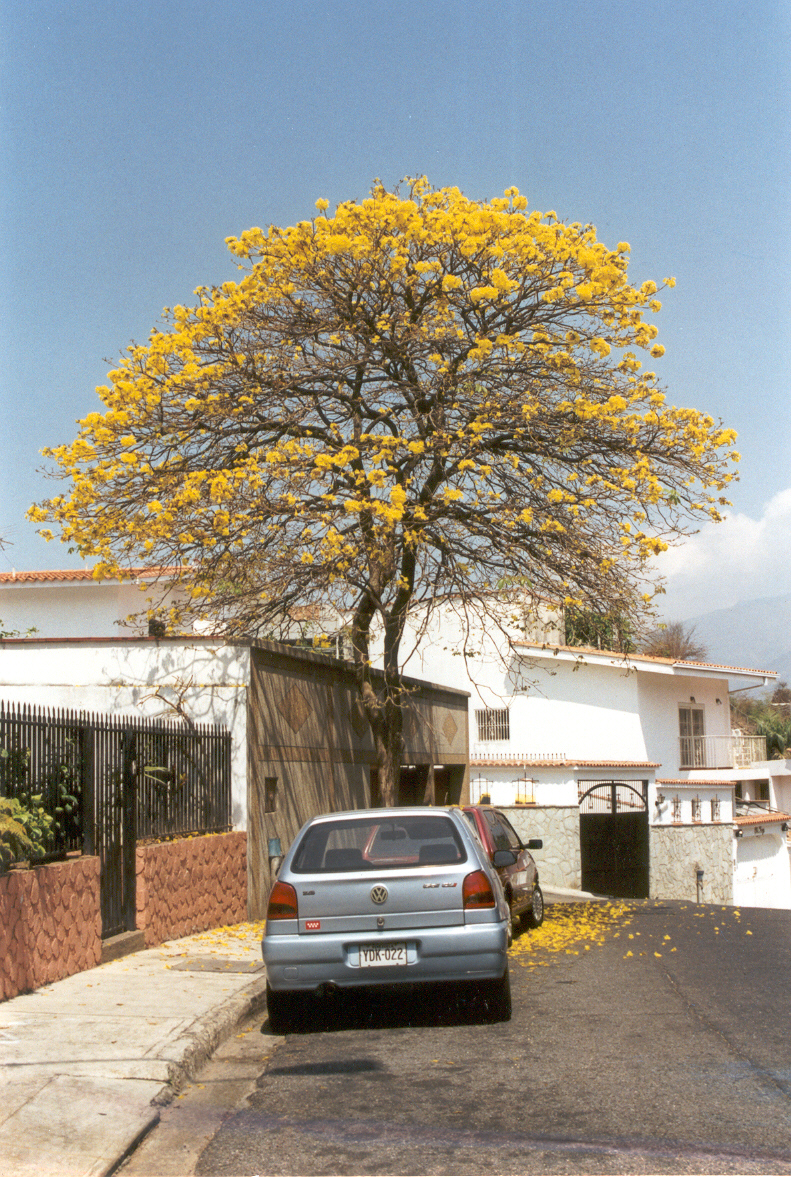- Tabebuia chrysantha
Taxobox
name = Araguaney

image_caption = Flowering "Tabebuia chrysantha" in a street of Caracas.
regnum =Plantae
divisio =Magnoliophyta
classis =Magnoliopsida
ordo =Lamiales
familia =Bignoniaceae
genus = "Tabebuia "
species = "T. chrysantha"
binomial = Tabebuia chrysantha
binomial_authority = (Jacq.) & G.Nicholson"Tabebuia chrysantha" (Araguaney or Yellow Ipê), known as "cañaguate" in northern Colombia [http://www.humboldt.org.co/conservacion/bignonaceae.html] , as "tajibo" in Bolivia, and as "ipê-amarelo" in
Brazil , is a native tree of the intertropical broadleaf deciduous forests ofSouth America above theTropic of Capricorn . OnMay 29 1948 , "Tabebuia chrysantha" was declared National Tree ofVenezuela since being an emblematic native species of extraordinary beauty. Its deep yellow resembles the one on the Venezuelan flag. It is one of about 100 species of "Tabebuia ".Designation
"Chrysantha" is derived from two Greek words and means "golden flower". Araguaney appears to derive from "aravenei", the ancient word by which
Carib es designated this tree.Habitat
The araguaney dwells in clearings of deciduous tropical forests of the broad guiana shield region [ [http://www.globalforestwatch.org/english/venezuela/index.htm Global Forest Watch - Overview of Venezuela] ] . It is also native to warm lands and sabanas (Vía Oriente to
El Guapo ,Cupira , andUchire Sabana) and even some arid hills (Mampote ,Guarenas ,Guatire yCaucagua ). Its habitat ranges 400 to 1300m above sea level.Description
It is a rustic
decidious tree that defies hard, dry or poor soils. Therefore its roots require well drained terrain. Its height ranges 6 to 12m. Leaves are opposite and petiolate, elliptic and lanceolate, with pinnate venation. Flowers are large, tubular shaped, with broadening corolla of deep yellow colour, about 2 inches long; they come out (February to April) before the tree has grown back any leaves. The fruit consists of dehiscent capsule often matured by the end of dry season. It is a slow growing, but long lasting, tree. [Hoyos F., Jesús (1983) "Guía de árboles de Venezuela", Caracas. Sociedad de Ciencias Naturales La Salle. Monografía Nº 32.]As said, flowering and fruiting take place in dry season, from February to April, this way the seeds can take advantage of early rains. If raining season is delayed, the araguaney may flower and fruit, mildly, a second time. It is a highly efficient moisture manager. As happens with mango, the araguaney biological functions requiring most water take place precisely during dry season.
Trivia
By the 1970s Ford Motor Company of Venezuela published a notorious cultural magazine named Aravenei (a name for araguaney). Its editor was famous twentieth century Venezuelan poet and writer
Juan Liscano . It dealt with varied articles of geographic, historical, and cultural relevance.References
*Hoyos F., Jesús (1983) "Guía de árboles de Venezuela", Caracas. Sociedad de Ciencias Naturales La Salle. Monografía Nº 32.
* [http://www.globalforestwatch.org/english/venezuela/index.htm Global Forest Watch - Overview of Venezuela]
Wikimedia Foundation. 2010.
